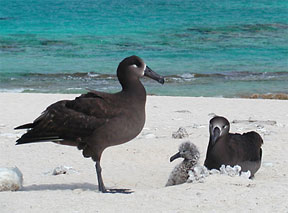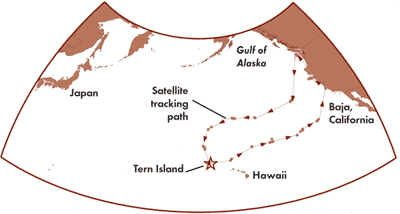Species of Concern Profile: Black-footed Albatross
December 2007
Imagine driving from Seattle to Maine to get lobster take-out for dinner. That’s about the distance that a Black-footed Albatross parent travels from its nesting grounds in Hawaii to the West Coast of the US to get a meal. It seems incredible that any animal would travel that far to look for food, but it must pay off because Black-footed Albatross regularly show up in the productive, upwelling waters from California to Washington in search of fish eggs, squid and small surface crustaceans.

For a brief moment, both Black-footed Albatross parents attend a chick on Tern Island. (C. Baduini)
With a wing span of more than two meters (!) Black-footed Albatross are masters of long distance travel. Long, narrow wings give albatross the benefit of a high aspect ratio—think airplane gliders—allowing them to literally surf the wind. Instead of flapping constantly, like a murre or a duck, albatross soar “dynamically” by coming in low over the ocean’s surface and banking into the wind. The flight pattern resembles a swooping, stretched-out slinky, and costs almost no energy. Albatross even have a special elbow notch, allowing them to lock their wings outstretched and give their muscles a break. These guys really are the “hybrids” of the bird world.
Returning to colonies in the northwest Hawaiian Islands in mid-October, Black-foots spend days getting reacquainted. Dancing, prancing, sky pointing, shy sideways looks and bill clapping are all part of the annual ritual. Females lay one egg a year, in November. Both parents incubate and attend the chick, but growth is a long process for such big birds; it takes until early summer for the young albatross to fledge.

How do we know where they go? This female Black-footed Albatross, satellite tagged on Tern Island, traveled a total of 12,000 km in 23 days in April 2007. (D. Anderson)
One of three albatross species in the North Pacific —Laysan and Short-tailed are the other two—Black-foots regularly wash up on COASST beaches along the West Coast, mainly in June and July, when parents are finally freed from the long months of tending to the chick. Our counts for Black-foots were highest in 2004 and 2005 (13 and 16), but our highest “capture” rate (BFAL per outer coast survey) occurred in 2001, when one in 20 surveys yielded a Black-foot find.